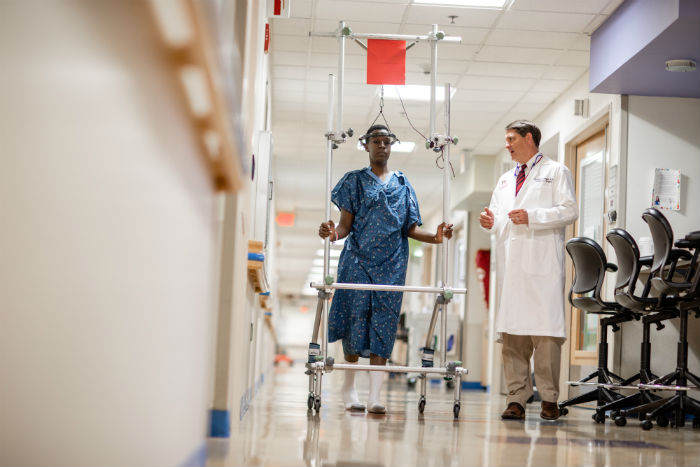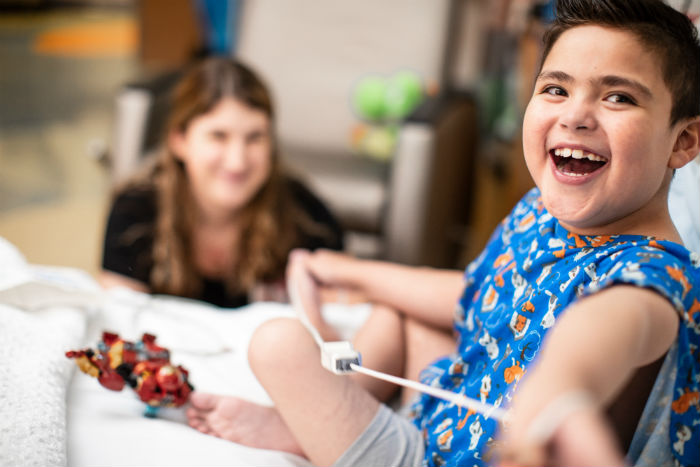Condition
Pediatric Marfan Syndrome
What is Marfan syndrome?
Marfan syndrome is a disorder involving the body's connective tissue. Connective tissue has many important functions, including the following:
- Assisting with growth and development of the body's cells, both before and after birth
- Supporting tissues in the body
- Acting as an adhesive to hold certain tissues together
- Protecting joints
- Facilitating the passage of light through the eye
A defective (FBN1) gene associated with Marfan syndrome affects the formation of a protein in connective tissue called fibrillin, which impacts the integrity of many organs and structures in the body. Organs and body systems that can be impacted include, but are not limited to, the following:
- Heart and major blood vessels
- Lungs
- Skeletal system
- Spinal cord
- Eyes
- Skin
According to the March of Dimes, more than 200,000 people in the U.S. are affected by Marfan syndrome. Marfan syndrome occurs in equal numbers in males and females, and also appears equally in all races and ethnic groups.
What is the treatment for Marfan Syndrom in children?
Specific treatment for Marfan syndrome will be determined by your child's health care provider based on:
- Your child's age, overall health and medical history
- Extent of the disorder
- Your child's tolerance for specific medications, procedures or therapies
- Expectations for the course of the disease
- Your opinion or preference
At the present time, there is no cure for the disorder. Treatment is based on determining which organ systems are affected and managing the problems that arise. Recommendations for managing Marfan syndrome may include the following:
- An annual echocardiogram, or echo (to monitor the heart and aorta)
- Periodic eye examination by an ophthalmologist
- Monitoring of the skeletal system for abnormalities (such as scoliosis) that can be noted in childhood or adolescence
- Lifestyle adjustments (to reduce the risk of injury to the aorta, such as avoiding contact sports or stressful exercise)
Genetic counseling is important for people who have Marfan syndrome and are planning to have a family. If one parent has the disorder, there is a 50% chance, with each pregnancy, for a child to also have Marfan syndrome. In addition, women with Marfan syndrome who become pregnant have significant risks for their health during pregnancy, due to the added stress that a pregnancy puts on the heart and aorta. Women with Marfan syndrome should consult with their health care providers before pregnancy to determine if pregnancy is safe for them.
What is the long-term outlook for a child with Marfan syndrome?
Heart and blood vessel problems pose the largest threat to a person with Marfan syndrome, which emphasizes the importance of regular evaluation by your child's health care provider. Consult your child's health care provider for more information regarding the specific outlook for your child.
With advances in the diagnosis, evaluation and management of the organ abnormalities associated with Marfan syndrome, the life expectancy for a person with the disease has nearly doubled in the past 25 years. Today, individuals with Marfan syndrome can expect to live about 70 years or more.
For women with Marfan syndrome, pregnancy and childbirth pose significant risks. These women should be evaluated with echocardiography prior to becoming pregnant. Other diagnostic imaging procedures, such as computed tomography angiography (CTA) or magnetic resonance angiography (MRA), may be used to assess risks. Cesarean delivery (C-section) is generally recommended for pregnant women with Marfan syndrome to prevent strain on the aorta and decrease the risk of aortic dissection during labor.
How is Marfan syndrome in children diagnosed?
In addition to a complete medical history and physical examination, your child's health care provider may complete a family medical history to look for other family members with known Marfan syndrome or some of the characteristics of the disease.
Other diagnostic tests for Marfan syndrome may include the following:
- Electrocardiogram (ECG or EKG). A test that records the electrical activity of the heart, shows abnormal rhythms (arrhythmias), and detects heart muscle damage.
- Echocardiography (echo). A procedure that evaluates the structure and function of the heart by using sound waves recorded on an electronic sensor that produce a moving picture of the heart and heart valves.
- Complete eye examination. An examination of the interior of the eye, performed by an ophthalmologist, using a device called a slit lamp.
- X-ray. A diagnostic test which uses invisible X-ray beams to produce images of internal tissues, bones and organs onto film.
- DNA studies. A blood sample sent to the genetics lab can analyze the FBN1 gene to determine whether a mutation is present; not all mutations in the fibrillin gene cause Marfan syndrome. Similarly, not all persons with Marfan syndrome have a mutation in this gene. Sometimes, a type of DNA study called a linkage study, which examines the DNA of several family members, can aid in tracking the gene in the family. However, because of these limitations, the diagnosis of Marfan syndrome is primarily based on clinical findings.
In order to be diagnosed with Marfan syndrome, your child must exhibit several characteristics from a detailed list. Your child needs to have a significant number of the symptoms on the checklist in order to be diagnosed with the disorder. Your child's health care provider will make the diagnosis based on medical and family history and other factors, as well as symptoms your child may exhibit.
Marfan syndrome may be easier to diagnose as children age, as many of the features of the disorder become more obvious as your child grows.
What is the treatment for Marfan Syndrom in children?
Specific treatment for Marfan syndrome will be determined by your child's health care provider based on:
- Your child's age, overall health and medical history
- Extent of the disorder
- Your child's tolerance for specific medications, procedures or therapies
- Expectations for the course of the disease
- Your opinion or preference
At the present time, there is no cure for the disorder. Treatment is based on determining which organ systems are affected and managing the problems that arise. Recommendations for managing Marfan syndrome may include the following:
- An annual echocardiogram, or echo (to monitor the heart and aorta)
- Periodic eye examination by an ophthalmologist
- Monitoring of the skeletal system for abnormalities (such as scoliosis) that can be noted in childhood or adolescence
- Lifestyle adjustments (to reduce the risk of injury to the aorta, such as avoiding contact sports or stressful exercise)
Genetic counseling is important for people who have Marfan syndrome and are planning to have a family. If one parent has the disorder, there is a 50% chance, with each pregnancy, for a child to also have Marfan syndrome. In addition, women with Marfan syndrome who become pregnant have significant risks for their health during pregnancy, due to the added stress that a pregnancy puts on the heart and aorta. Women with Marfan syndrome should consult with their health care providers before pregnancy to determine if pregnancy is safe for them.
What is the long-term outlook for a child with Marfan syndrome?
Heart and blood vessel problems pose the largest threat to a person with Marfan syndrome, which emphasizes the importance of regular evaluation by your child's health care provider. Consult your child's health care provider for more information regarding the specific outlook for your child.
With advances in the diagnosis, evaluation and management of the organ abnormalities associated with Marfan syndrome, the life expectancy for a person with the disease has nearly doubled in the past 25 years. Today, individuals with Marfan syndrome can expect to live about 70 years or more.
For women with Marfan syndrome, pregnancy and childbirth pose significant risks. These women should be evaluated with echocardiography prior to becoming pregnant. Other diagnostic imaging procedures, such as computed tomography angiography (CTA) or magnetic resonance angiography (MRA), may be used to assess risks. Cesarean delivery (C-section) is generally recommended for pregnant women with Marfan syndrome to prevent strain on the aorta and decrease the risk of aortic dissection during labor.
How is Marfan syndrome in children diagnosed?
In addition to a complete medical history and physical examination, your child's health care provider may complete a family medical history to look for other family members with known Marfan syndrome or some of the characteristics of the disease.
Other diagnostic tests for Marfan syndrome may include the following:
- Electrocardiogram (ECG or EKG). A test that records the electrical activity of the heart, shows abnormal rhythms (arrhythmias), and detects heart muscle damage.
- Echocardiography (echo). A procedure that evaluates the structure and function of the heart by using sound waves recorded on an electronic sensor that produce a moving picture of the heart and heart valves.
- Complete eye examination. An examination of the interior of the eye, performed by an ophthalmologist, using a device called a slit lamp.
- X-ray. A diagnostic test which uses invisible X-ray beams to produce images of internal tissues, bones and organs onto film.
- DNA studies. A blood sample sent to the genetics lab can analyze the FBN1 gene to determine whether a mutation is present; not all mutations in the fibrillin gene cause Marfan syndrome. Similarly, not all persons with Marfan syndrome have a mutation in this gene. Sometimes, a type of DNA study called a linkage study, which examines the DNA of several family members, can aid in tracking the gene in the family. However, because of these limitations, the diagnosis of Marfan syndrome is primarily based on clinical findings.
In order to be diagnosed with Marfan syndrome, your child must exhibit several characteristics from a detailed list. Your child needs to have a significant number of the symptoms on the checklist in order to be diagnosed with the disorder. Your child's health care provider will make the diagnosis based on medical and family history and other factors, as well as symptoms your child may exhibit.
Marfan syndrome may be easier to diagnose as children age, as many of the features of the disorder become more obvious as your child grows.
$name

Innovation DistrictApr 18, 2024
Novel cell therapy treatments offer promise to immune-compromised children
.jpg)
Feb 19, 2019
Rebecca's StoryAt only 15-days old, Rebecca would need to undergo surgery to treat intestinal malrotation and volvulus. Find out how Children's team used minimally invasive surgery to treat the infant.

Jun 10, 2016
Irina's StoryWhen Irina and her husband first learned their infant daughter had a serious health condition, they immediately began researching the best doctors and surgeons to care for her. Read about Irina's story.

Sep 23, 2022
Giving Bella Hope for a Brighter FutureIn the first weeks of life, Bella underwent a series of procedures that her doctors and family agreed were necessary to end constant seizures from hemimegalencephaly (HME), a rare brain disorder in which one half of the brain grows abnormal and large and misbehaves by triggering repeated difficult seizures.

May 01, 2024
Youth Pride ClinicThe Youth Pride Clinic provides primary and specialty care to adolescent LGBTQ (lesbian, gay, bisexual, transgender and questioning) patients.
Apr 18, 2024
Meet the Team
$name

Rare Disease Institute
Children’s National Rare Disease Institute (CNRDI) is a first-of-its-kind center focused exclusively on advancing the care and treatment of children and adults with rare genetic diseases.

Orthopaedic Surgery and Sports Medicine
From sprains and strains to complex congenital conditions, Children’s National Hospital offers one of the most experienced pediatric orthopaedic practices in the nation with experience in treating all areas from head to toe.

Spine Program
Children’s National offers children with spinal deformities a range of treatments, including innovative casting techniques, and hope for a bright future.

Childhood Cancer Genetics
Our cancer genetics experts help answer important questions about your child’s inherited risk for cancer.



